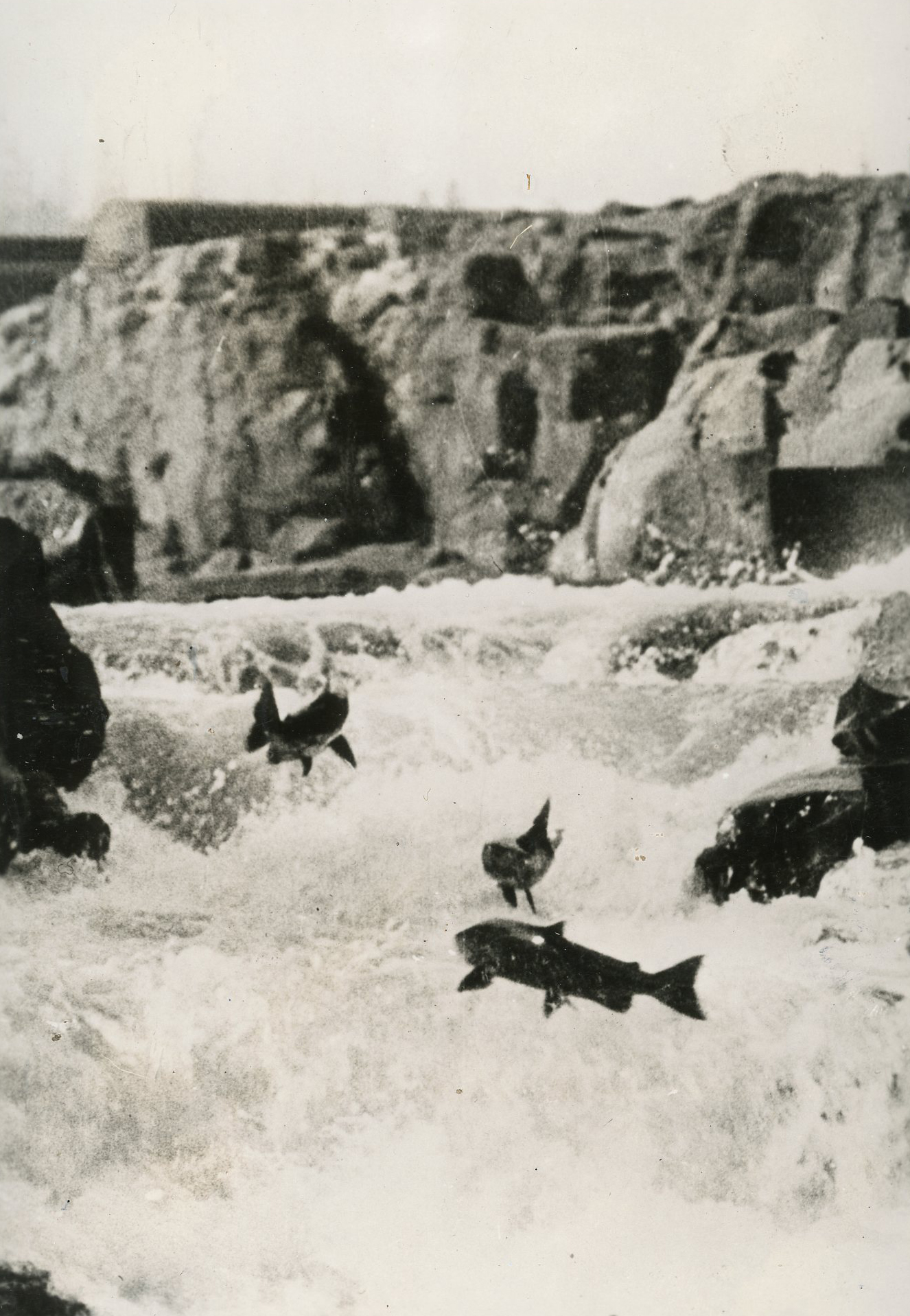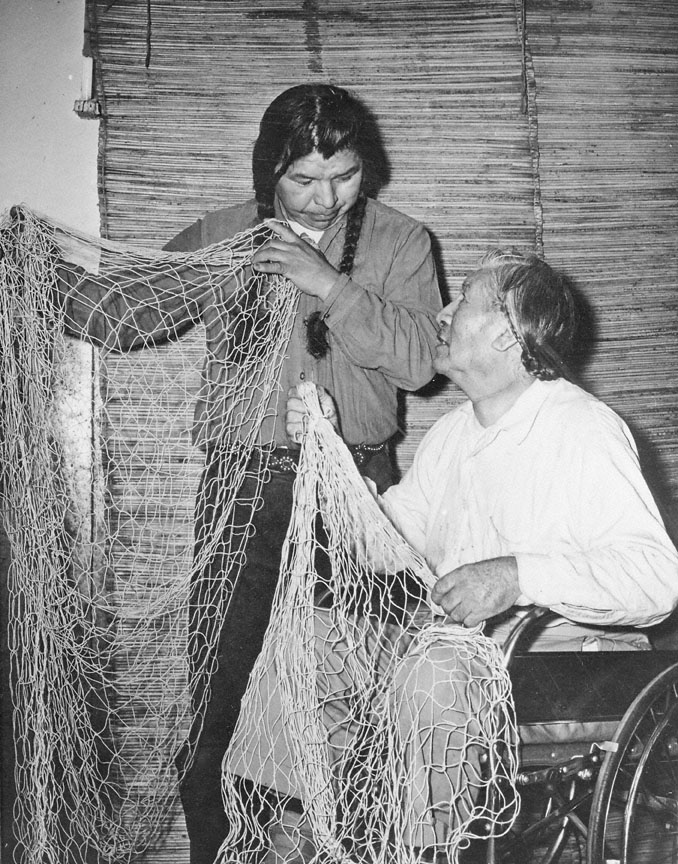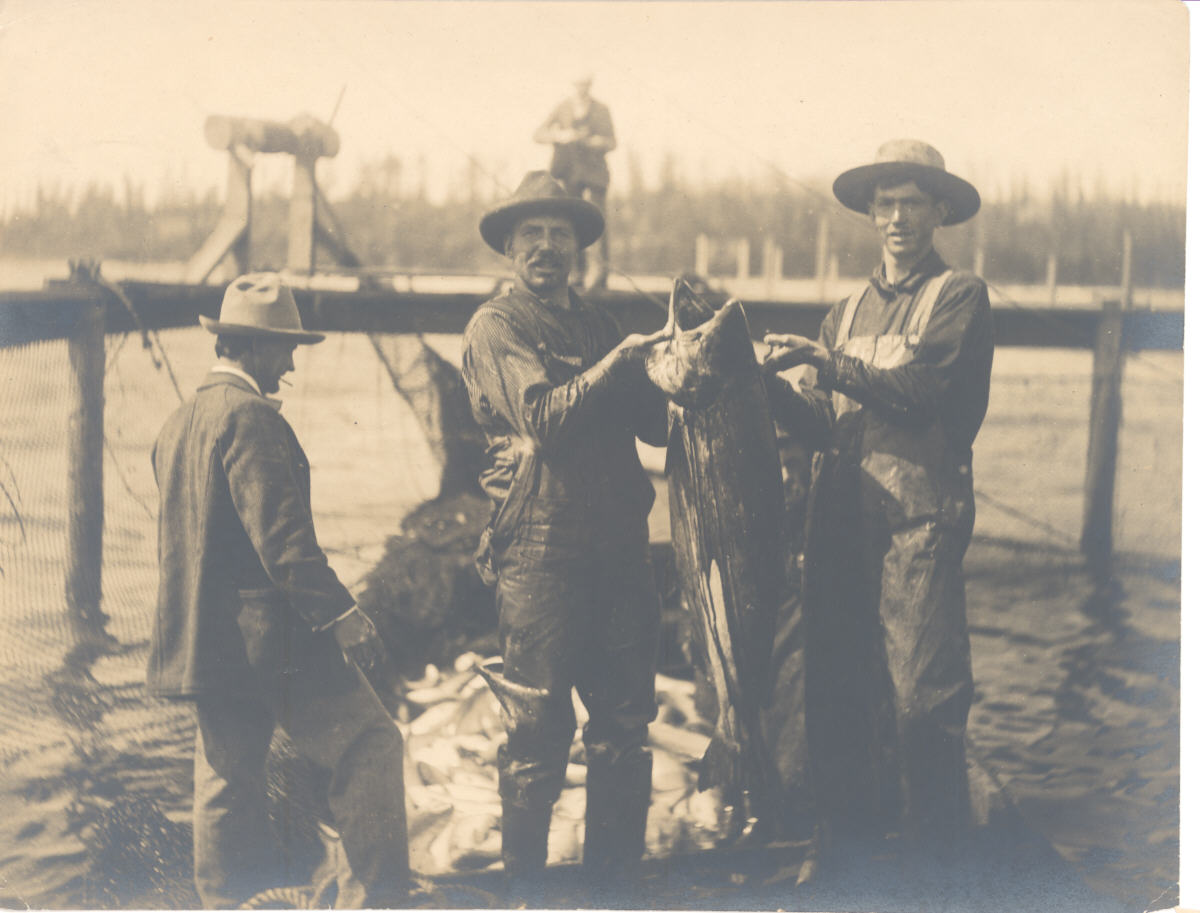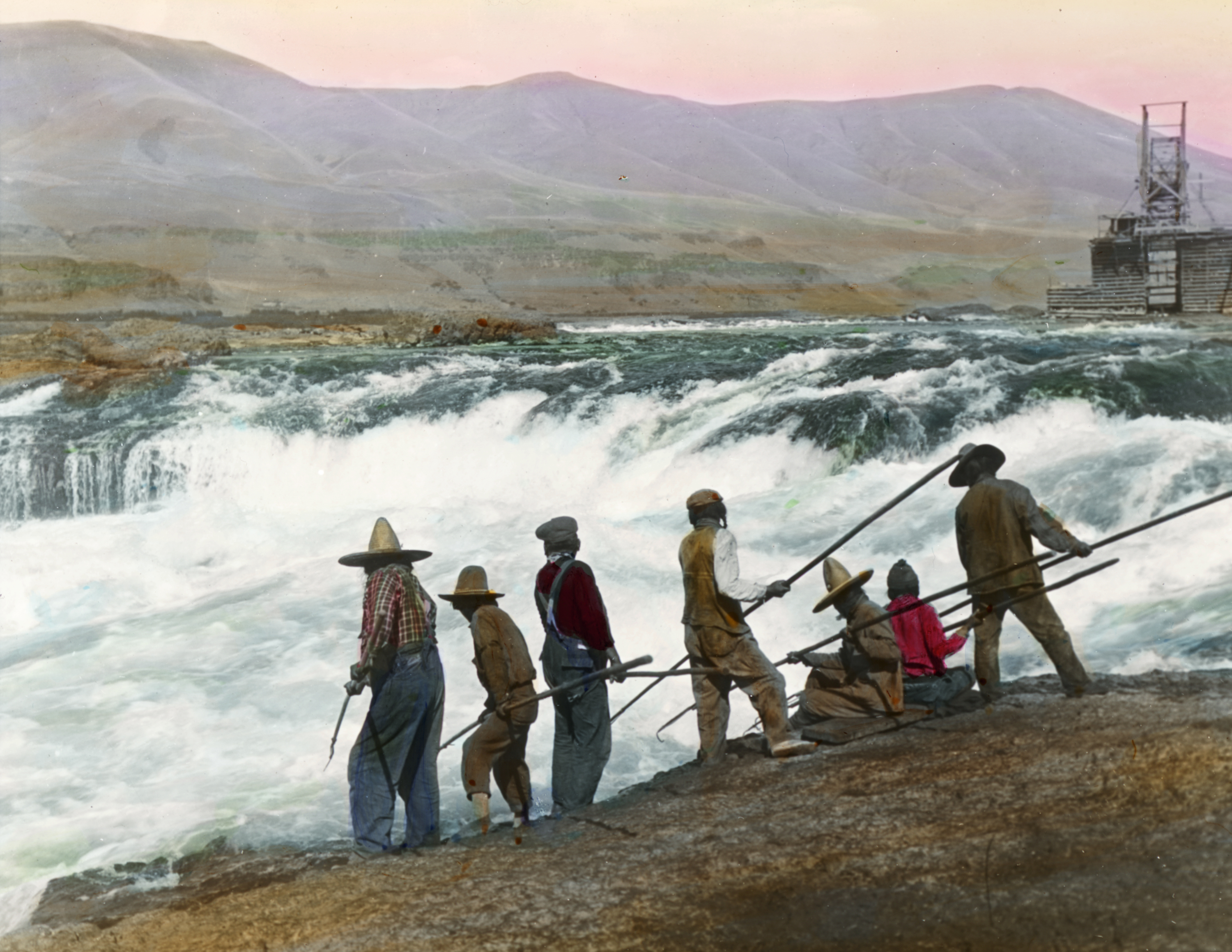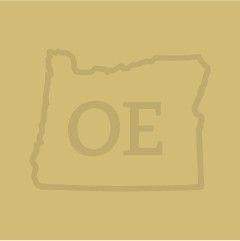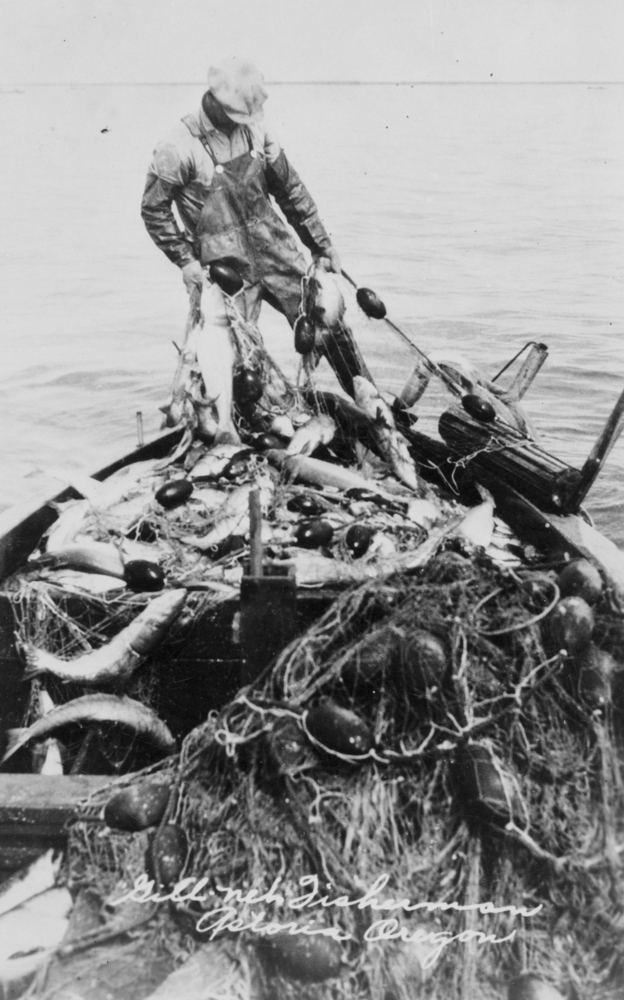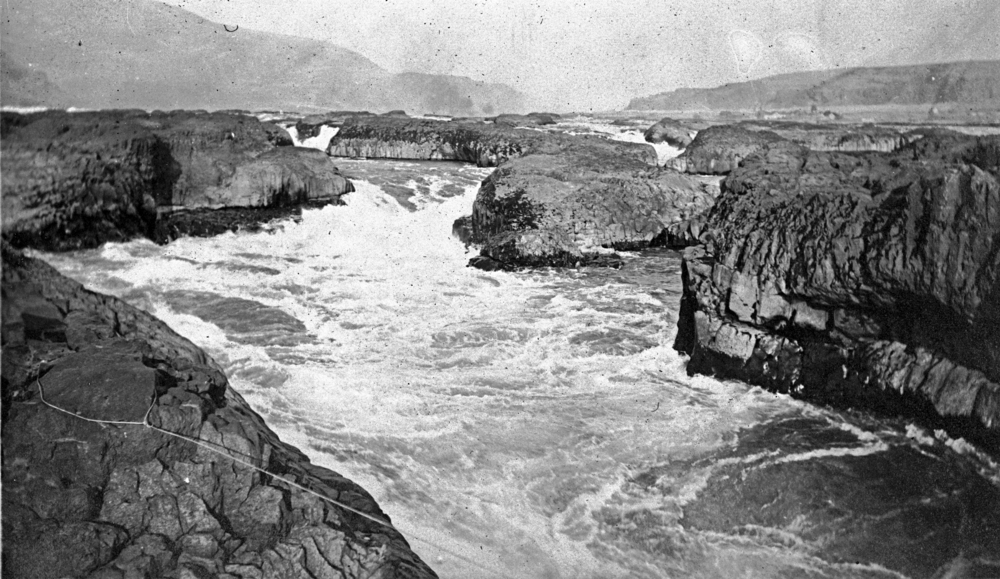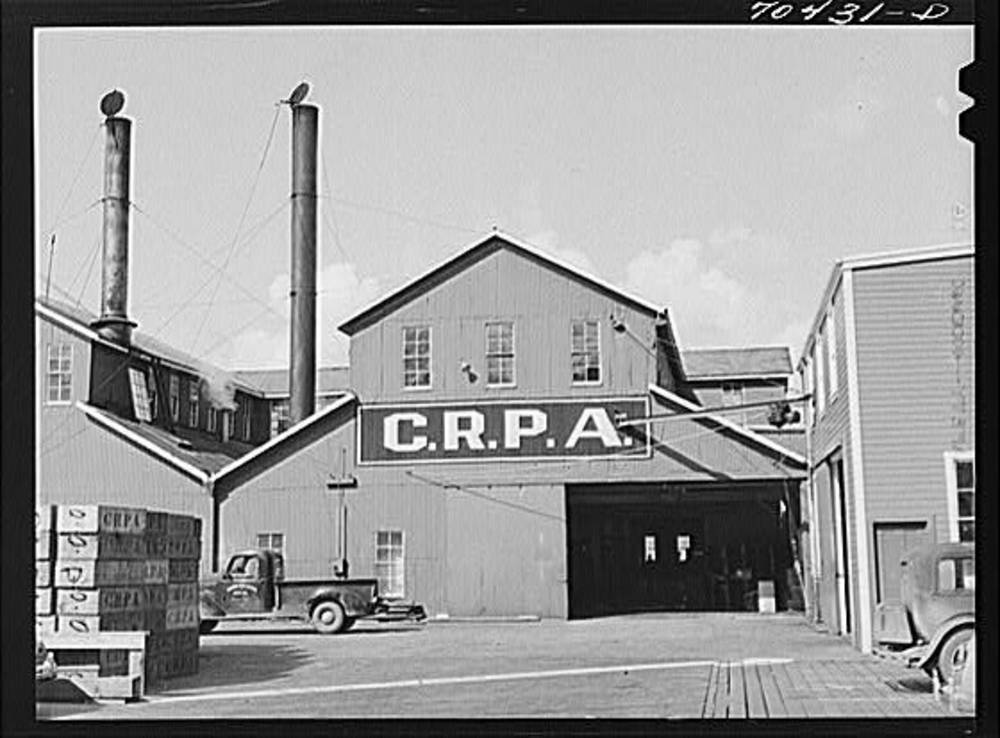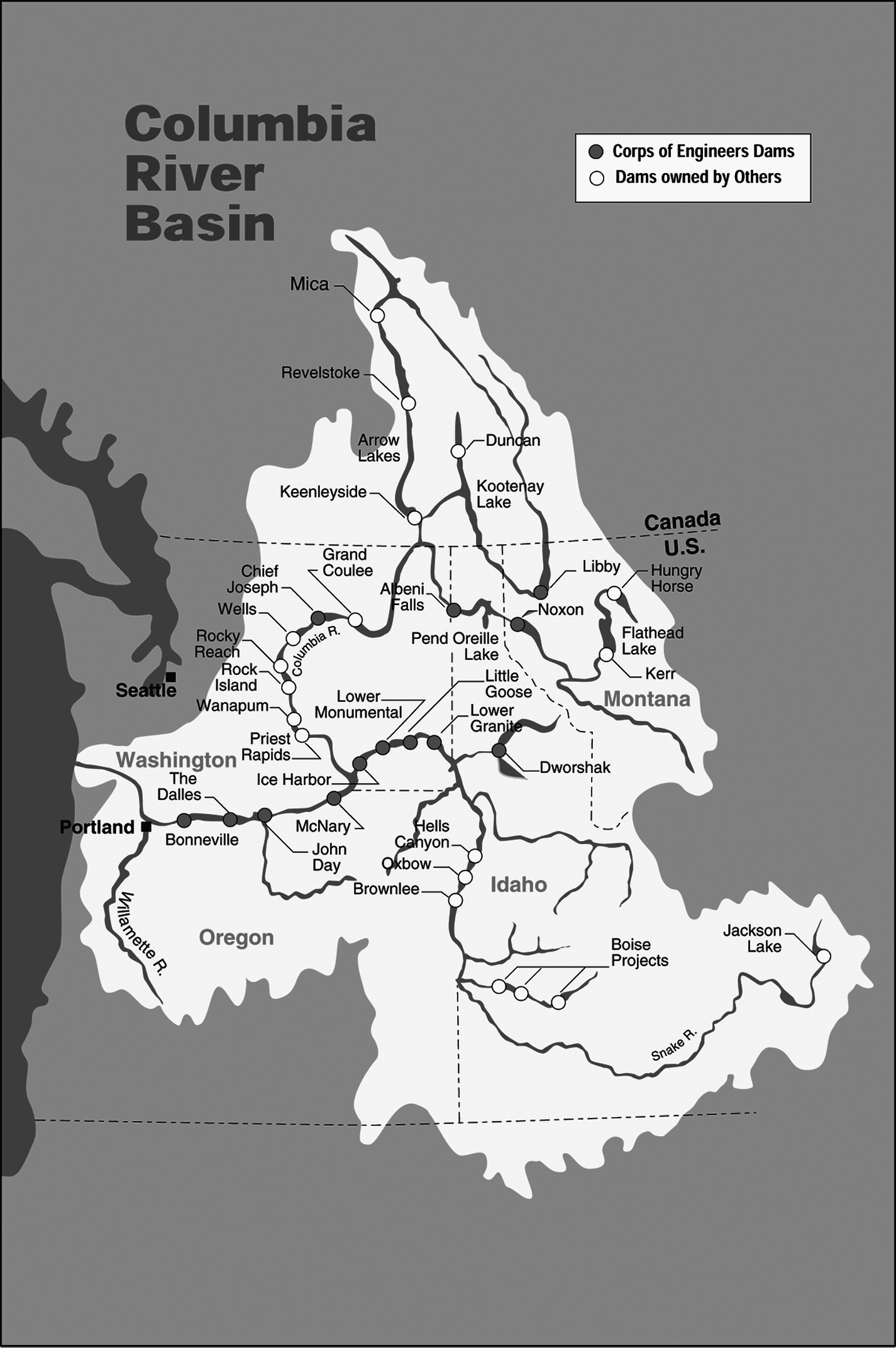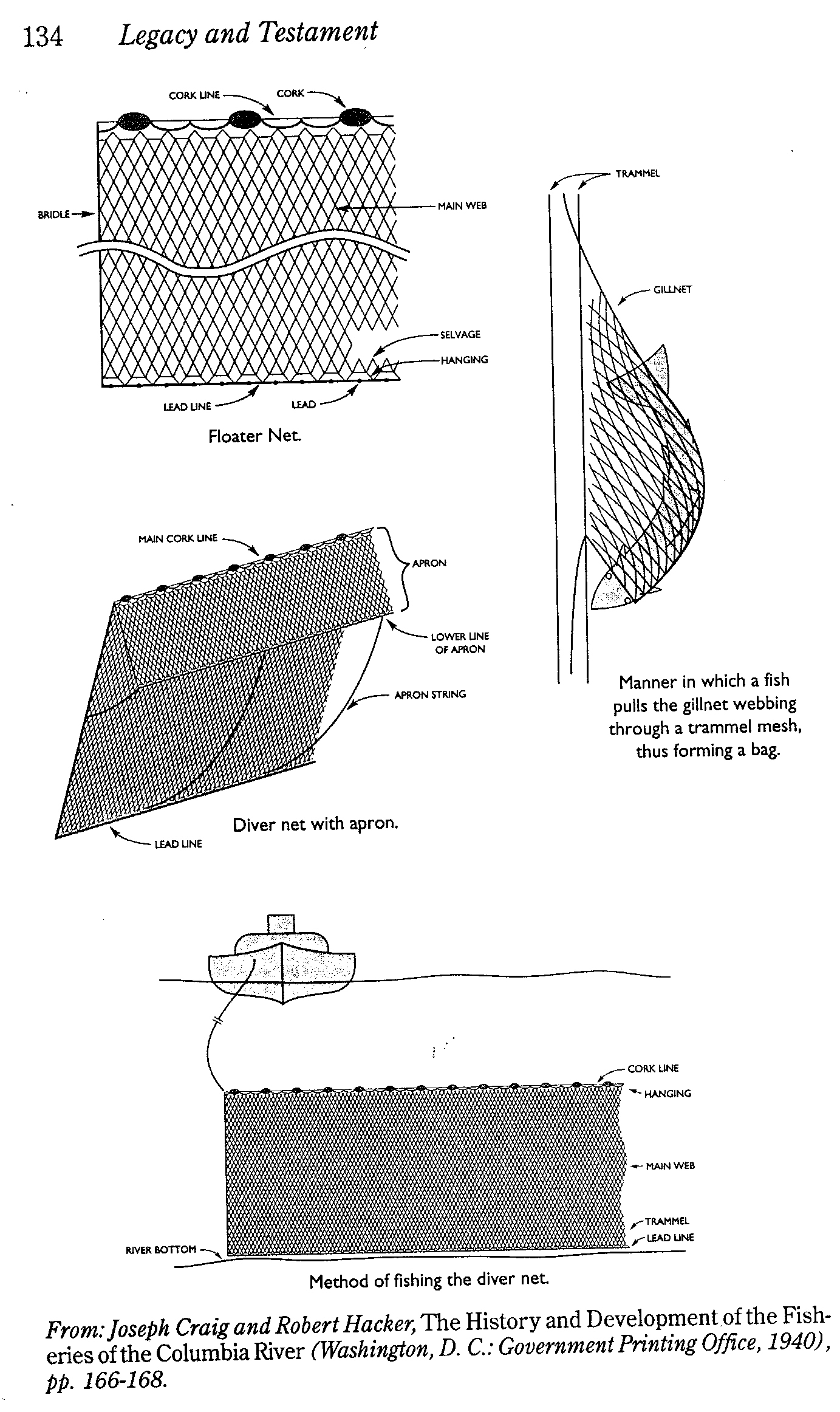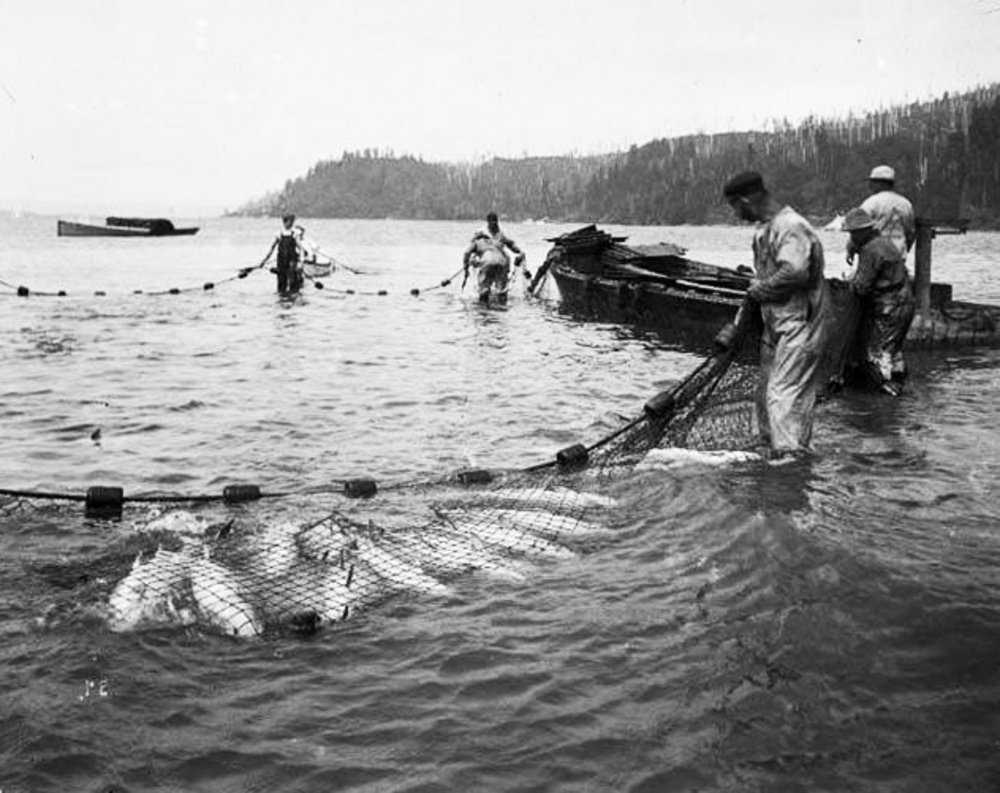“Salmon” originally meant Atlantic salmon (Salmo salar), a species native to the North Atlantic rim and Arctic Ocean above Western Europe. In 1972, however, the taxonomist Johann Julius Walbaum applied the name to a group of fishes native to the watersheds of the North Pacific and Arctic in eastern Asia and western North America.
In Oregon, “salmon” has mostly referred to six species of the genus Oncorhynchus, known colloquially as Chinook (O. tshawytscha), coho (O. kisutch), sockeye (O. nerka), chum (O. keta), pink (O. gorbuscha), and steelhead (O. mykiss). Since the 1980s, salmon farming has provided S. salar to consumers, and escaped fish have begun to invade the habitats of native species.
All salmon are anadromous, spawning in fresh water but maturing in oceans, and most are semelparous, spawning once and then dying; but there is tremendous diversity within and between species. When juveniles hatch from eggs, some move immediately to sea while others spend up to two years in fresh water before migrating. Some steelhead (rainbow trout) and sockeye (kokanee) remain in fresh water their whole lives. Atlantic salmon, many steelhead, and a few coho can spawn repeatedly, but all salmon require cool, flowing water to survive and gravel riverbeds to spawn.
Salmon was a dietary staple of Northwest aboriginal people. Large, tasty, and available at predictable times and places, the fish were an ideal source of protein, easily caught with basic fishing technologies such as spears, baskets, nets, and brush weirs. Salmon were so important that Native peoples featured them in oral traditions as spiritually powerful beings. Of these tales, anthropologist Dell Hymes observed that it was salmon “who determines future destinies.”
Natives harvested salmon all across western Oregon and the Columbia River Basin, but several sites were particularly important, including Willamette Falls, Kettle Falls, Celilo Falls, and The Dalles. Natives from around western North American gathered at these places because the large salmon runs could feed vast numbers of people on a seasonal basis. People who lived around The Dalles also produced a unique commodity of dried salmon that the Lewis and Clark Expedition noted was packed into ninety-pound baskets, traded widely, and remained edible for as long as two years.
Beginning with Robert Gray’s 1792 visit to the Columbia River, aboriginal fishers sold fresh salmon to traders, explorers, trappers, and settlers. For these EuroAmericans, salmon was also a fish of destiny, nourishing famished bodies and occasionally ameliorating scurvy.
Population Decline
Salmon’s material and cultural importance declined with agrarian resettlement. The fish were important food and trade items for the Hudson’s Bay Company in the 1820s and 1830s, and they would continue to matter to industrial fishers after 1866; but the people who depended on salmon composed an ever-shrinking portion of society.
Farmers, ranchers, loggers, miners, and urbanites dramatically transformed regional ecology after 1840. Damming, diking, and dredging directly altered riverine habitat. The timber industry’s practice of using splash dams to float logs to mills with flash floods scoured spawning gravels, while increased forest fires, plowing, grazing, and development suffocated river bottoms in silt.
Beginning in 1866 on the lower Columbia River and extending to the Willamette, Snake, and coastal streams by 1890, industrial fishers deployed an array of technologies—hooks, gill nets, seines, weirs, traps, and fishwheels—to intercept adult salmon returning from the ocean to their spawning grounds. These harvests were substantial but not significantly greater than precontact takes. The devastation instead came from the combination of intensive harvests and extensive losses to spawning and rearing habitat.
Meanwhile, non-Indians felt ever-less concern for salmon. Some Protestants disdained the fish, linking it to what they viewed as superstitious Catholic practices of abstaining from meat on Fridays, but many more simply saw unaltered habitat as an obstacle to progress.
Far from fading from significance, diminishing salmon runs fueled the development of governmental and economic structures. Having witnessed similar fishery implosions in California in 1865 and New England in 1830s, in 1877 a group of Columbia River canners formed the Oregon and Washington Fish Propagation Company. The commissioner of the US Commission of Fish and Fisheries—a man who had credited artificial propagation with the “power not only to maintain the present supply of fish indefinitely, but to increase it if desirable”—sent chief fish culturist Livingston Stone to help build the region’s first salmon hatchery on the Clackamas River. That fall, canner R. D. Hume built another hatchery on the Rogue River.
The 1877 downturn was caused by a severe El Niño; but when runs rebounded with better ocean conditions, observers instead credited hatcheries. By 1890, private salmon conservation had given way to ever-more extensive efforts by state and federal agencies to make salmon and regulate harvests.
Fishers organized. Gillnetters formed the Columbia River Fisherman’s Protective Union in 1876 and allied with the American Federation of Labor in 1885. Canners responded with their own cartels, including the Alaska Packers Association (1893) and the Columbia River Packers Association (1899). Anglers formed clubs, and in 1908 they began to use Oregon’s and Washington’s voter initiative processes to outlaw commercial netting. Like many Oregonians, little slowed the decline. Governments built hatchers across the region, transplanted eggs freely between watersheds, and restricted the timing and gear of harvest. Native and industrial fishers tried to stop dam construction. Anglers condemned Native and industrial fishers. The effect over time was to shift catch allocations to non-Indian fishers and to segregate harvests between blue-collar laborers at sea and middle-class anglers in rivers.
No group willingly accepted restrictions on itself, however, and damage to rearing and spawning habitat only accelerated when hydroelectric, irrigation, and municipal water supply dams were built at Willamette Falls (1888), Bull Run (1895), Swan Falls (1902), and Spokane Falls (1920). In the 1920s, federal investigators surveyed the Columbia River’s dam sites, and three dams were built across the Columbia in the 1930s: Rock Island (1931), Bonneville (1937), and Grand Coulee (1941). Grand Coulee was particularly significant because it lacked provisions for juvenile and adult fish passage, thus closing access to 1,100 miles of spawning grounds. Among the casualties was a population of very large Chinooks, called June Hogs for the month in which they returned to the Columbia, that regularly weighed over sixty pounds.
Over time, these trends changed the nature of salmon. In 1938, Congress passed the Mitchell Act, authorizing construction of many more hatcheries to mitigate the ecological impact of big dams. This represented the institutionalization of previous ad hoc actions by the states and the federal government that favored development over habitat protection.
The plan set forth by the US Bureau of Fishers in the 1940s sought to relocate reproduction to the lower Columbia River Basin, far below Grand Coulee Dam and even below Bonneville Dam. Sockeye eggs from British Columbia’s Arrow Lakes were transplanted to the Yakima and Metolius basins. Upstream Chinook eggs were transplanted to the Wenatchee basin. Logjams and beaver dams were cleared to open spawning grounds in the Klickitat and Cowlitz basins.
Concern for lower river spawning accelerated proscriptions against nets, but the growth of ocean trolling and dam-building on the Cowlitz, Deschutes, and Willamette Rivers offset these reforms. By the 1950s, fishing regulation had become more difficult because most of the harvest occurred beyond the three- and twelve-mile limits of state and federal sovereignty. International treaties with Canada and Japan tried to impose order, but there was growing awareness that salmon originating from the Columbia Basin and the coastal rivers of Oregon and Washington were caught as far away as the west coast of Vancouver Island and Alaska.
Balancing Protection and Industry
Innovations in fish feeds in the 1960s enabled hatchers to husband juveniles for longer periods. In 1960, Oregon instituted the Smolt Plan, which resulted in fewer juveniles being raised but higher survival rates until ocean migration. One consequences of these interventions, however, was that harvests, dams, and hatcheries began to select for different traits than in naturally reproduced populations, thus deflecting salmon onto new evolutionary paths.
During the 1960s, the new policies seemed successful, as salmon runs rebounded. When ocean conditions deteriorated in the 1970s, however, researchers gained a far more complex view of the factors affecting salmon. Following a shift in ocean climate in 1977 (now linked to the Pacific Decadal Oscillation and the North Pacific Gyre Oscillation) and a very severe El Niño in 1982, researchers reinterpreted the strong returns of the 1950s and 1960s as a function of ecological conditions rather than technical prowess. Concerns mounted over the cumulative effects of dams on salmon runs due to lost spawning beds, warmed waters, poor fish passage, and nitrogen super saturation. River pollution drew attention, as did deleterious practices by grazers, irrigators, loggers, and miners.
In 1980, Congress responded by passing the Northwest Power Act, which created the Northwest Power Planning Council (now called the Northwest Power and Conservation Council) to create policies that better balanced the needs of fish and wildlife with hydroelectric and barging demands. Hatcheries also drew criticism for narrowing gene pools, producing inferior fish, and selecting for behaviors not conducive to survival in the wild. In response, private landowners, tribes, and the states adopted a range of reforms to hatchery procedures, including small hatchbox efforts on coastal streams, acclimation ponds that rear juvenile salmon under more natural conditions, and systemic attention to genic variations among “evolutionarily significant units” of salmon populations.
Nature itself seemed increasingly unstable. Caspian terns, for example, colonized sand islands in the estuary on the lower Columbia, where they preyed heavily on juvenile salmon. Bull rout, seals, and sea lions ate fish stalled below dams. Oceans could affect fish recruitment for good and ill. In the 1990s, the US Environmental Protection Agency listed many salmon populations as threatened or endangered under the 1973 Endangered Species Act.
Disagreements among states, tribal groups, industries, property owners, and environmentalist organizations over federal and state management plans—known as Biological Opinions, or Bi-Ops—drew the federal courts into regulation. The consequences of these developments include an ever-diminishing non-Indian commercial fishery, increased influence among treaty Indians, technical innovations at dams, and court rulings that consistently emphasize the need for greater attention to naturally reproducing runs and ecologically resilient habitat.
As ocean conditions improved after 2000, some runs began to rebound; but the basic, long-term problems with wild salmon remain a key concern. Underscoring these issues, the only resilient runs in the Columbia River Basin spawn in the Hanford Reach, the only remaining free-flowing section of the river. That fifty-mile stretch of river is adjacent to the Hanford Nuclear Reservation and has been off-limits to development since 1942. The Hanford Reach salmon remind us that the ecological conditions that sustain wild salmon are now largely understood but that the region’s social and economic complexity make attaining those conditions difficult. The human interventions of the last 150 years mean the salmon we now value and consume are different from the fish that Lewis and Clark encountered.
-
![]()
Salmon migrating up Willamette Falls.
Photo by Ralph Eddy. Courtesy Oreg. Hist. Soc. Research Library, 53943
-
![]()
Salmon from Ten Mile Creek, Oregon.
Courtesy Oregon Hist. Soc. Research Lib., Orhi102505, pf390f
-
![Jimmy George and Charley Quittoken with fishing nets, 1957]()
Jimmy George and Charley Quittoken with fishing nets, 1957.
Jimmy George and Charley Quittoken with fishing nets, 1957 Courtesy Oreg. Hist. Soc. Research Library, CN007246
-
![Fishermen and their catch]()
Fishermen and their catch.
Fishermen and their catch Courtesy Oreg. Hist. Soc. Research Library, 60433
Related Entries
-
![Bonneville Dam]()
Bonneville Dam
The U.S. Army Corps of Engineers built and operated Bonneville Lock and…
-
![Celilo Falls]()
Celilo Falls
Celilo Falls (also known as Horseshoe Falls) was located on the mid-Col…
-
![Celilo Fish Committee (1935 - 1957)]()
Celilo Fish Committee (1935 - 1957)
Members of Umatilla, Yakama, and Warm Springs tribes joined unenrolled …
-
![Columbia River Fisherman's Protective Union]()
Columbia River Fisherman's Protective Union
The Columbia River Fishermen's Beneficial Aid Society was organized on …
-
![Columbia River Inter-Tribal Fish Commission]()
Columbia River Inter-Tribal Fish Commission
The Columbia River Inter-Tribal Fish Commission (CRITFC) is the fishery…
-
![Columbia River Packers Association]()
Columbia River Packers Association
In the 1890s, efforts to form an association of salmon packers on the l…
-
![Columbia River Treaty (1964)]()
Columbia River Treaty (1964)
The high-voltage power lines that march across central Oregon, linking …
-
![Gillnet fishing]()
Gillnet fishing
A gillnet is used by fishermen throughout the world to catch various sp…
-
![Northwest Power Act (1980)]()
Northwest Power Act (1980)
In 1980, after four years of deliberation and several attempts, Congres…
-
![Seine Fishing]()
Seine Fishing
For much of their fishing history in Oregon, Native Americans used hand…
Related Historical Records
Further Reading
Cone, Joseph, and Sandy Ridlington. The Northwest Salmon Crisis: A Documentary History. Corvallis: Oregon State University Press, 1996.
Hymes, Dell H. “Language, Memory, and Selective Performance, Cultee’s ‘Salmon Myth’ as Twice Told to Boas.” Journal of American Folklore 98 (October 1985): 427.
Montgomery, David. King of Fish: The Thousand-Year Run of Salmon. New York, NY: Basic Books, 2003.
Taylor, Joseph E. III. Making Salmon: An Environmental History of the Northwest Fisheries Crisis. Seattle: University of Washington Press, 1999.
Blumm, Michael C. Sacrificing the Salmon: A Legal and Policy History of the Decline of Columbia Basin Salmon. Den Bosch, Netherlands: BookWorld Publications, 2002.

